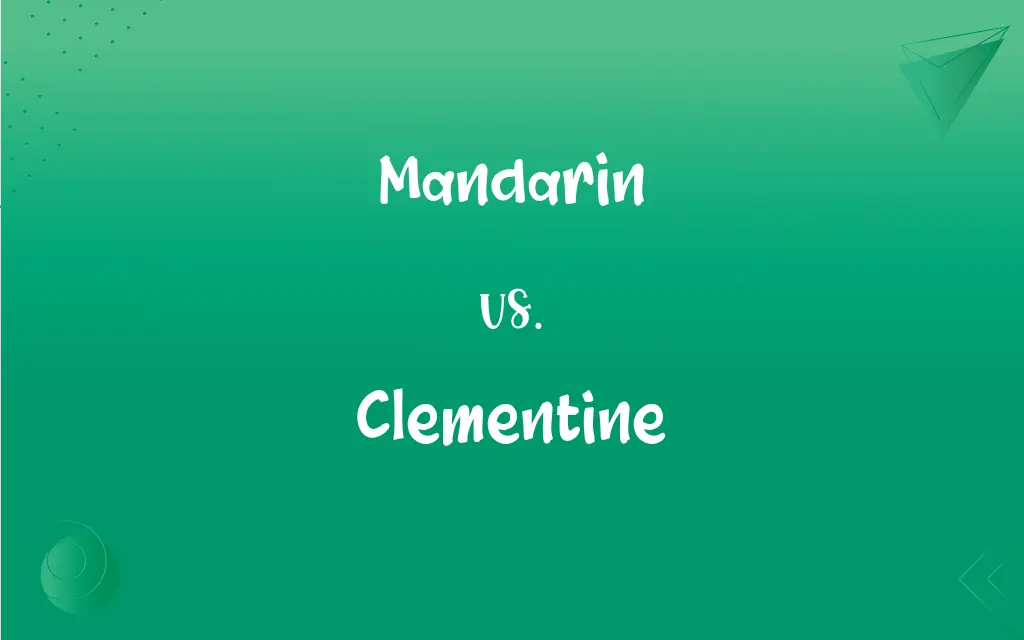Mandarin vs. Clementine: What's the Difference?
Edited by Aimie Carlson || By Harlon Moss || Updated on October 11, 2023
Mandarins are a class of oranges with thin, peelable skin and sweet flavors, while clementines are a seedless mandarin hybrid, smaller and sweeter, also with a peelable skin.

Key Differences
Mandarins, Citrus reticulata, represent a category of citrus fruit, popular for their sweet flavor and easy-to-peel skin. Clementines are essentially a subtype of mandarin, widely loved for their sweetness and virtually seedless nature. Both fruits belong to the Rutaceae family, sharing certain characteristics while distinctly differing in various aspects, such as size and seed presence.
Looking closely at the mandarin, you'll notice its slightly flattened shape and vibrant orange, loose, and pebbly skin. Its flavor leans towards sweet with a hint of tartness, and it may contain seeds, depending on the variety. Clementines, often called “Christmas oranges” due to their winter peak season, are notably sweeter, smaller, and typically lack seeds, presenting a friendlier option for certain consumers.
The mandarin orange provides various hybrids and varieties, including tangerines, which are often mistakenly considered synonymous. Clementines, being a hybrid of the mandarin, specifically bring forth a distinctive, sweet, and juicy flavor, remarkably easy to separate into segments, and are broadly utilized in salads, desserts, and as snacks due to their seedless and easy-to-peel nature.
Cultivation of mandarins spans across the globe, with China being the largest producer, offering several varieties differing in sweetness, size, and even color. Clementines, though grown worldwide as well, are predominantly cultivated in Mediterranean regions, contributing to their sometimes alternative name, “Mediterranean mandarins.”
Both mandarins and clementines are nutrient-dense, offering a wealth of vitamin C alongside other vitamins and minerals. The notable absence of seeds in clementines represents a genetic variation that, while making them easy to eat, also requires human intervention in their propagation, contrasting with the naturally occurring seeds in many mandarin varieties.
ADVERTISEMENT
Comparison Chart
Size
Generally larger
Typically smaller
Seeds
May contain seeds
Generally seedless
Sweetness
Sweet with possible tartness
Sweeter
Cultivation Regions
Widely grown, notably in China
Predominantly Mediterranean
Varieties
Includes various hybrids and types
Is itself a type of mandarin
ADVERTISEMENT
Mandarin and Clementine Definitions
Mandarin
Historically, Mandarin can refer to a high-ranking Chinese bureaucrat.
The mandarin implemented new policies in the province.
Clementine
A clementine is a small, sweet, and typically seedless variety of mandarin.
She enjoyed a juicy clementine as a mid-morning snack.
Mandarin
Mandarin refers to a type of citrus fruit, known for its sweet flavor.
The mandarin was delightfully sweet and refreshing.
Clementine
Clementine can be a feminine given name.
Clementine wrote a beautiful poem about the ocean.
Mandarin
In linguistic terms, Mandarin denotes the official language of China.
He speaks Mandarin fluently, making communication in China smooth.
Clementine
In popular culture, "Clementine" refers to a well-known American folk ballad.
The lyrics of Oh My Darling, Clementine are melancholic and nostalgic.
Mandarin
In color theory, Mandarin is a vibrant shade of orange.
Her dress was a striking mandarin, catching everyone’s eye.
Clementine
Sometimes, clementine is used to describe a bright orange color, similar to the fruit.
The sunset painted the sky in shades of clementine and pink.
Mandarin
Mandarin can also describe something relating to the Chinese culture or language.
He teaches Mandarin literature at the university.
Clementine
Geologically, Clementine refers to a NASA mission to the Moon.
The Clementine mission provided valuable data about the Moon's surface.
Mandarin
Any of a group of related dialects of Chinese spoken principally in the north and west of China.
Clementine
A deep red-orange, often seedless mandarin orange.
Mandarin
The official national standard spoken language of China, based on the Mandarin dialect spoken in and around Beijing. Also called Guoyu, Putonghua.
Clementine
A type of small, sweet orange, the result of a cross between a tangerine and Seville orange.
Clementine
Of or pertaining to Clement, esp. to St. Clement of Rome and the spurious homilies attributed to him, or to Pope Clement V. and his compilations of canon law.
Clementine
A variety of mandarin orange that is grown around the Mediterranean and in South Africa
Clementine
A mandarin orange of a deep reddish orange color and few seeds
FAQs
Is a tangerine a mandarin?
Yes, a tangerine is a specific variety of mandarin.
Where are mandarins cultivated?
Mandarins are cultivated worldwide, with notable production in China.
What is a mandarin?
A mandarin is a type of citrus fruit, characterized by its sweet flavor and easy-to-peel skin.
Can you substitute mandarins for clementines in recipes?
Yes, mandarins and clementines can often be used interchangeably in recipes.
What is the nutritional value of mandarins?
Mandarins are rich in vitamin C, fiber, and antioxidants.
What’s the difference in the peels of mandarins and clementines?
Both have easy-to-peel skins, but mandarins tend to have slightly looser peels.
Are clementines genetically modified to be seedless?
Clementines are not genetically modified but are a naturally occurring mandarin hybrid.
Are mandarins and clementines available all year?
While available much of the year, peak seasons may vary between regions.
How many varieties of mandarins are there?
There are numerous mandarin varieties, including tangerines and clementines.
How is a clementine different from a mandarin?
A clementine is a variety of mandarin that is smaller, sweeter, and typically seedless.
How should clementines be stored?
Clementines can be stored at room temperature or in the refrigerator for longer freshness.
Do mandarins have seeds?
Some mandarins have seeds while others, like clementines, typically do not.
What does the name "mandarin" originate from?
The name "mandarin" relates to the Chinese officials ("mandarins") who once received these fruits as gifts.
Why are clementines associated with Christmas?
Clementines peak in winter and have been traditionally enjoyed and gifted during the Christmas season.
What other fruits are related to mandarins and clementines?
Oranges, tangerines, satsumas, and grapefruits are all related citrus fruits.
Can you grow clementines at home?
Yes, clementines can be grown at home, given suitable conditions.
Can mandarins and clementines be juiced?
Yes, both fruits can be juiced, though clementines may yield sweeter juice.
Are mandarins and clementines safe for pets to eat?
In small amounts, they may be safe for some pets, but always consult a vet first.
Is the mandarin orange the same as a mandarin?
All mandarin oranges are mandarins, but not all mandarins are recognized as mandarin oranges.
What dishes are mandarins used in?
Mandarins are used in salads, desserts, and savory dishes, or eaten fresh.
About Author
Written by
Harlon MossHarlon is a seasoned quality moderator and accomplished content writer for Difference Wiki. An alumnus of the prestigious University of California, he earned his degree in Computer Science. Leveraging his academic background, Harlon brings a meticulous and informed perspective to his work, ensuring content accuracy and excellence.
Edited by
Aimie CarlsonAimie Carlson, holding a master's degree in English literature, is a fervent English language enthusiast. She lends her writing talents to Difference Wiki, a prominent website that specializes in comparisons, offering readers insightful analyses that both captivate and inform.
































































